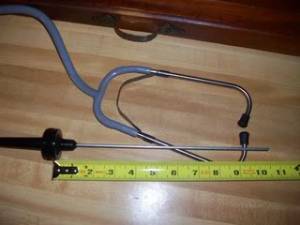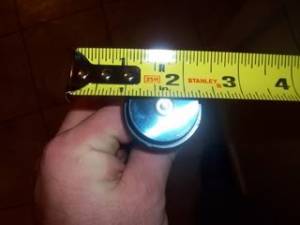Table of Contents
This is an old revision of the document!
REF: General-MSR 06
Using a Stethoscope or Other to Hunt Down Engine Noises
See also Hunting Down Sportster Noises in the Sportsterpedia for examples of what some noises sound like and their origin.
Normally, you'd use all of your senses on an engine. 1)
Look at it, (oil leaks ?, obvious bad signs).
Listen to it, (both with and without a stick).
Feel it, (try a broken crank one time!).
Smell it, (bad gas or oil?).
But like anyone diagnosing things, experience gives you the ability. It just takes time.
The “sounds” in a Sportster engine can be quite disturbing, very much like the engine is going to blow up. 2)
Literally like a tin can of marbles.
What you need to do is to determine if it is the normal sound or if something is wrong.
It is very difficult, almost impossible, to isolate the source of a noise while riding.
There are pros and cons (as in other subjects) to using this listening method.
Sound, and it's interpretation, is a totally subjective thing.
What 'sounds' bad to one doesn't to another.
You'll here noises from all over the engine. 3)
The trick is being able to decipher which ones come from where and if they sound correct or not.
Unfortunately, experience is the best teacher here and you do need a known good engine as a reference point.
However, this method can be used to hear differences in moving parts in the engine.
Using a stethoscope is an excellent way of comparing similar areas, such as lifters, pushrods, etc. 4)
A slightly tight valve train won't make the same sound as a properly adjusted valve.
But it's readily apparent when using a stethoscope. Same for rocker arms.
A quick probe around with a stethoscope now and then alleviates some worry about what might be missed otherwise.
The 'scope' is just another tool to find the general area of the noise.
And there is nothing wrong with using all the tools at your disposal to diagnose and troubleshoot.
It still can be difficult to nail down the exact cause of the noise without visual inspection of the parts.
When you first try it, you're likely trying to pinpoint the source of a particular sound to isolate the area you'd need to disassemble.
But, in some instances, it can be like chasing ghosts by trying to do this with a stethoscope.
The unfortunate reality is that you'll have to break the motor down into 'sections by section' to track down what's ailing it. 5)
That's a hard pill to swallow if the noise you hear is not detrimental by nature.
Or, bite the bullet and take it to an experienced wrench with enough experience to at least narrow things down a bit.
But that may also be a subjective opinion.
This method is also good for detecting air leaks.
When you're riding, it's even harder to pinpoint where the noise is generating from. 6)
You can use a stethoscope, screwdriver or a length of hose or an older method with a wooden stick.
A stethoscope can be purchased inexpensively at Princess Auto, Harbor Freight or others.
If you haven't listened to your healthy engine before with either screwdriver or stethoscope etc., 7)
You've got no reference or comparison as to what you should be listening to when your engine isn't so healthy.
With a bit of experience, it's easier with these to pin point if you're listening to a full speed or a half-speed noise.
That can help in diagostics as in crank versus cams.
But the 1st time you're using them on a very healthy engine, it just sounds like it's gonna blow any minute.
Stethoscope
Use caution when using a stethoscope.
It has a diaphragm in the middle of the tube (attached to the probe rod) that amplifies the sounds that you are hearing. 8)
This amplified sound can hurt your ears when simply scraping the probe across engine parts (or even your finger).
| Mechanic stethoscope. 9) The black partition at the end of the tape measure is where the diaphragm is. Note the size of the diaphragm. |
|
 |  |
A wooden dowel also works well. 10)
Hold one end to the engine and stick the other end against your ear.
The dowel not only lets you hear the sounds but it will also let you feel them.
There is a distinct difference in feel on the wood from a ticking noise and a knocking noise.
A stethoscope may sound louder in this instance.
But a wooden dowel may feel a harder tap easier.
With the engine at idle listen at:
- All 4 rocker ends, both sides of the engine.
- All 4 pushrods, top, middle and bottom.
- All 4 lifter blocks.
- All 4 cams, listening thru the gearcase cover.
- Both ends of the generator (if applicable).
All similar points should sound about the same, like rotating steel parts.
For exhaust leaks:
- Listen around the head ports and any joints for a ticking sound.
For future maintenance:
It is worthwhile to do this process a couple of times a year, just to keep track of stuff.
It's also a very good idea to do this when the engine is running well so that you know what running well sounds like thru the stethoscope.
Critical listening:
You can miss something if you don't pick up and reposition the probe.
Some noises are caught up in the same frequencies as other noises on the bike.
You have to decide what you're listening to and where it's coming from.
Noises travel (or transfer) all over the engine and the bike.
Sometimes blocking out certain known noises can help you hear others.
There is the fact of listening and then there is the process of critical listening when diagnosing noises.
In example, listen to any recorded song.
Then play it back and only listen for a certain instrument and block out the others.
That's critical listening.
Apply that to the engine parts as they move.
